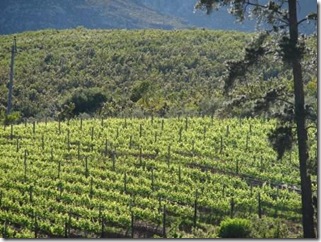Stony patch
There’s a weak spot in our Cabernet Franc vineyard. These vines were planted in the year 2000 and so every one is 7 years old. Fifty seven of these vines have not grown to the same height, dimension or strength as the others.
This doesn’t suit us as we need every vine to produce grapes that ripen at once, just the way female impala buck have their calves on the same day as each other.
Vines that have different growth patterns ripen their grapes at varying rates. Grapes on strong vines may be ripe today, but the weak one, next in the row, will only reach the same state in a week’s time. To make wonderful wine, you can’t pick both vines on the same day and make all of the juice into wine. One vine with grapes that have green, unripe flavours will reduce the pleasure of the total.
Before we harvest this block, the grapes from the weaker vines will be cut off and dropped on the ground, and will play no part in the winemaking.
Fortunately, the weak ones are all together in a small group. We have isolated them.
Why are they different? We don’t know. The soil preparation and vineyard care were the same for all.
The vines of course are all virtually identical cuttings. It’s possible that there is more broken shale stone in the soil under this patch than elsewhere in the vineyard.
If that is so, then the roots will grow down into lower-lying soil and these vines will strengthen and one day catch up the rest.
We’ll have to wait and see.
Technorati Tags:
gaping void wine, gapingvoid wine, stormhoek, stormhoek vineyard, stormhoek wine, stormhoke wine, wine 2.0








3 Comments, Comment or Ping
David Brain
That’s really interesting. I had no idea that the vines had to produce at the same time, but of course, it makes total sense. I love the randomness of it . . . but I bet it turns your hair grey.
Nov 23rd, 2007
Esra Stidnab
Nice post. I’ll think of the little backward vines when I drink some of your Cabernet Franc.
Nov 29th, 2007
Graham Knox
The co-ordination of ripening rates of each grape-berry to get all to harvest day at the same sugar content and, more importantly, ripeness of flavour, involves managing issues like the land (soil), the strength (genetic) of the vine, the date of flowering and the number of bunches and leaves on each and every vine. You can’t plan for random mishaps, like the arrival of birds with sweet tooths and the subsequent loss of half of one vine’s grapes, but you have to react to them. In the case of bird damage, we would probably cut off and throw away all of the bunches on a vine like this.
Nov 30th, 2007